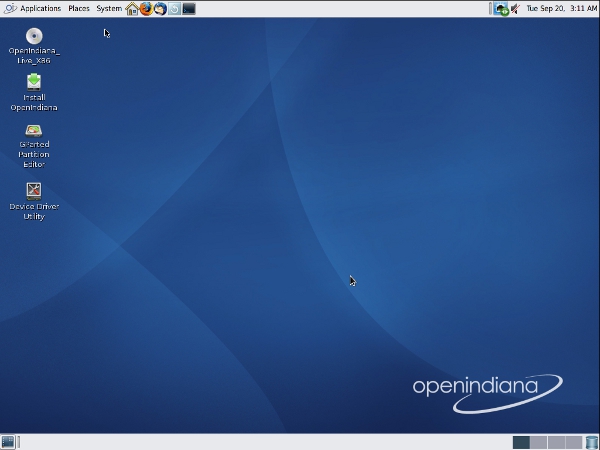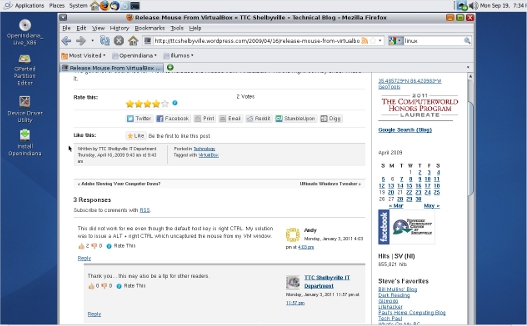As always, the free software community and the technology world in general are in a constant state of flux. Once you get used to the way that things operate, you can be certain that they are going to change. A lot of surprising events occurred recently: Intel teamed up with Google, Microsoft teamed up with Arm, and a controversy brewed over whether Windows 8 will lock out GNU/Linux, FreeBSD, and other free operating systems. The world of free software is NEVER boring. The Linux Week in Review 19 brings you these fantastic three stories:
- Intel’s Atomic Love Affair With Google’s Android Boots Up
- Openindiana Takes Over Where Opensolaris Left Off
- Message to Redmond: Stop Making Unilateral Decisions For Us
Intel’s Atomic Love Affair With Google’s Android Boots Up
The marriage of Atom and Android looks like a match made in heaven, and it just might prove to be an Ipad killer. Intel’s Atom is a microprocessor designed specifically for devices that need to run on electrical power off of the grid for long periods of time. Netbooks, tablets, and other mobile devices are all fair game for the Atom processor. Android is on a ferocious path towards becoming the world’s most popular operating system, so a marriage with the world’s most popular microprocessor manufacturer seems like a natural progression. Obviously, our friends in Redmond are NOT going to be happy with this development.
Medfield is an upcoming version of the Atom processor, and Intel recently announced a partnership with Google to put the Medfield in a future Android tablet. I suspect that this partnership will lead to A LOT of Intel powered Android devices. So who wins and who loses? Google and Intel are the obvious winners. The two technology giants joining forces is analogous to stacking Lebron James and Dwyane Wade on the same basketball team: you are destined to win. Both companies are committed to open source technologies, and both are extremely popular worldwide. Microsoft and Apple probably have the most to fear from this alliance. It is yet to be seen whether either of them will end up losers in this deal. The Apple market is extremely robust, and I think that the new competition will only make Apple better. It will sharpen their focus, so that their product quality remains high. Microsoft, on the other hand, faces an uphill battle in the mobile market. Windows 8 looks pretty sweet (I wrote this segment before the recent news of a potential GNU/Linux lockout in Windows 8), but it is coming from a position of being far behind Android and IOS in terms of market share. The biggest winner in all of this competition is the consumer!
Openindiana Takes Over Where Opensolaris Left Off
OpenIndiana is a new, free software operating system based on the Illumos kernel. The Illumos Project is a fork of the old OpenSolaris Project. The Illumos kernel development team aimed to make the Illumos kernel binary compatible with all software written to run on Solaris. The relationship is very analogous to the relationship between Red Hat and Centos, except that Solaris is not open source. The story of how OpenIndiana and Illumos came to be is a somewhat complex one. Basically, Oracle decided that it was going to discontinue the Opensolaris Project because it was not considered to be profitable. The OpenSolaris volunteers were left out in the cold. A group of Solaris engineers decided that all of the work done on OpenSolaris should not be for naught. They decided to tell Oracle to fork itself, and they went on to create OpenIndiana. The resulting OpenIndiana operating system that the engineers and the volunteer community came up with is basically OpenSolaris with all of the non-free bits removed. What does OpenIndiana mean for the GNU/Linux community? It means that we have one more free software friend that is welcome to join the ever expanding group of freedom-based communities. The demand for free software is enough to support GNU/Linux, Illumos, FreeBSD, Android, and all other free software operating systems.
Most of the code in the OpenIndiana project is licensed under the Common Development and Distribution License (CDDL). It can be downloaded as a USB or DVD disk image, and it looks a lot like most GNU/Linux distributions. The reason for this is that it uses the familiar Gnome desktop environment. I downloaded the OpenIndiana image, and ran it on a virtual desktop in both KVM (on Fedora 15) and VirtualBox (on Windows 7). It is a nice operating system with all of the familiar Gnome apps. I will play with OpenIndiana for the next few weeks, and I will report my reactions in a later edition of TLWIR.
Message to Redmond: Stop Making Unilateral Decisions For Us
The news that Microsoft’s Windows 8 may come with a “secure boot” function that may effectively lock out other operating systems is just the latest in a long and disturbing trend. Just as free software is giving people more computing freedom than ever, our friends in Redmond continue to make ideations of doing what is best for us. The basic message is this: if only you knew better, you would not run GNU/Linux or FreeBSD because they are not safe. The lame excuse that this move to require Microsoft keys to run software as a way of preventing rootkit attacks is bogus. This is all about regaining control. Computing software is more diverse and heterogeneous than it has ever been. Apple is dominating tablet computing, Android is dominating on mobile phones, GNU/Linux is doing very well on servers, and MS Windows still dominates the desktop. Diversity is healthy. However, Microsoft’s latest move threatens to take us back to 1995, when they were very few choices. However, people are a lot smarter about computing now than they were in 1995: this is not going to fly. If Windows 8 ships with secure boot enabled on most pcs, it will be DOA. Hopefully, someone in Redmond will wise up long before Windows 8 ships. Computer user in 2011 and beyond expect choices. We are smart enough to decide what we want to run for ourselves, thank you very much.
Conclusions
It looks like we are headed for a big showdown between free software and proprietary software in the next couple of years. Evidence of this is everywhere to be seen: Samsung facing off with Apple over Android, Red Hat facing of with Microsoft over Windows 8, and Google facing off with Oracle in their patent disputes. I would get out the popcorn because it is going to be a great show. Better yet, if you love free software, I encourage you to vote with your dollars. If Windows 8 pcs do lock GNU/Linux out, then I have bought my last pc. I WILL find an alternative. However, I suspect that the issue will be resolved long before the next generation of pcs appear. Have fun and please enjoy your freedom. I look forward to seeing you in the next edition of TLWIR.
References
- Kerner, S. M. (2011, September 21). Red hat engineer calls out windows 8 secure boot as a linux risk. Retrieved September 23, 2011, from http://www.internetnews.com/blog/skerner/red-hat-engineer-calls-out-windows-8-secure-boot-as-a-linux-risk.html
- Vaughan-Nichols, S. J. (2011, September 14). Google and intel android pairing spells trouble for microsoft. ZD Net. Retrieved September 14, 2011, from http://www.zdnet.com/blog/open-source/google-and-intel-android-pairing-spells-trouble-for-microsoft/9545




